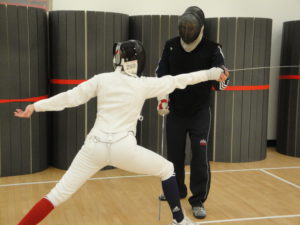During the process of teaching to groups, it will be necessary from time to time to give individual attention to athletes not progressing as fast as others, or who might need a particular technical point explained and practiced.
It will also be necessary to give individual lessons from time to time to better members of the group in order to maintain interest and enthusiasm.
Thus the individual lesson is a necessary part of a coach’s work and will help keep the progress of the group in balance. A certain amount of time during each practice session should be allocated to dealing with individuals one on one. If there is another coach in attendance, one could continue the group lessons whilst the other is dealing with the individual aspect of the lesson.
The Lesson
There are several guidelines to follow when giving a fencing lesson:
- Give instructions in a voice loud enough to be heard by the athlete only
- Keep these commands short and concise – no lengthy explanations
- Give your command before you give the appropriate opening with the sword
- It should not be necessary to give commands for stepping forward – backward etc. The athlete should develop a natural sense of maintaining the distance throughout the lesson.
- Coaches should use their own sword and unarmed hand to correct the athlete’s position.
- When giving openings/invitations, make them smooth and easy so the athlete can respond under control.
- Alternate between offensive and defensive actions.
- Provide frequent opportunities for rest and recovery, use these moments to inject additional explanation. This will keep the athlete in a state where they can concentrate and perform.
Coach’s Stance
During an individual lesson the stance of the coach differs significantly from that of the athlete. The coach’s stance is reflective of the number of lessons the individual coach may have to give. This stance is far more relaxed and conservative of movement than that of the athlete.
Key points:
- Feet positioned a less than 90°
- Legs slightly straight
- Back arm carried alongside the body ready to use in correcting the student


